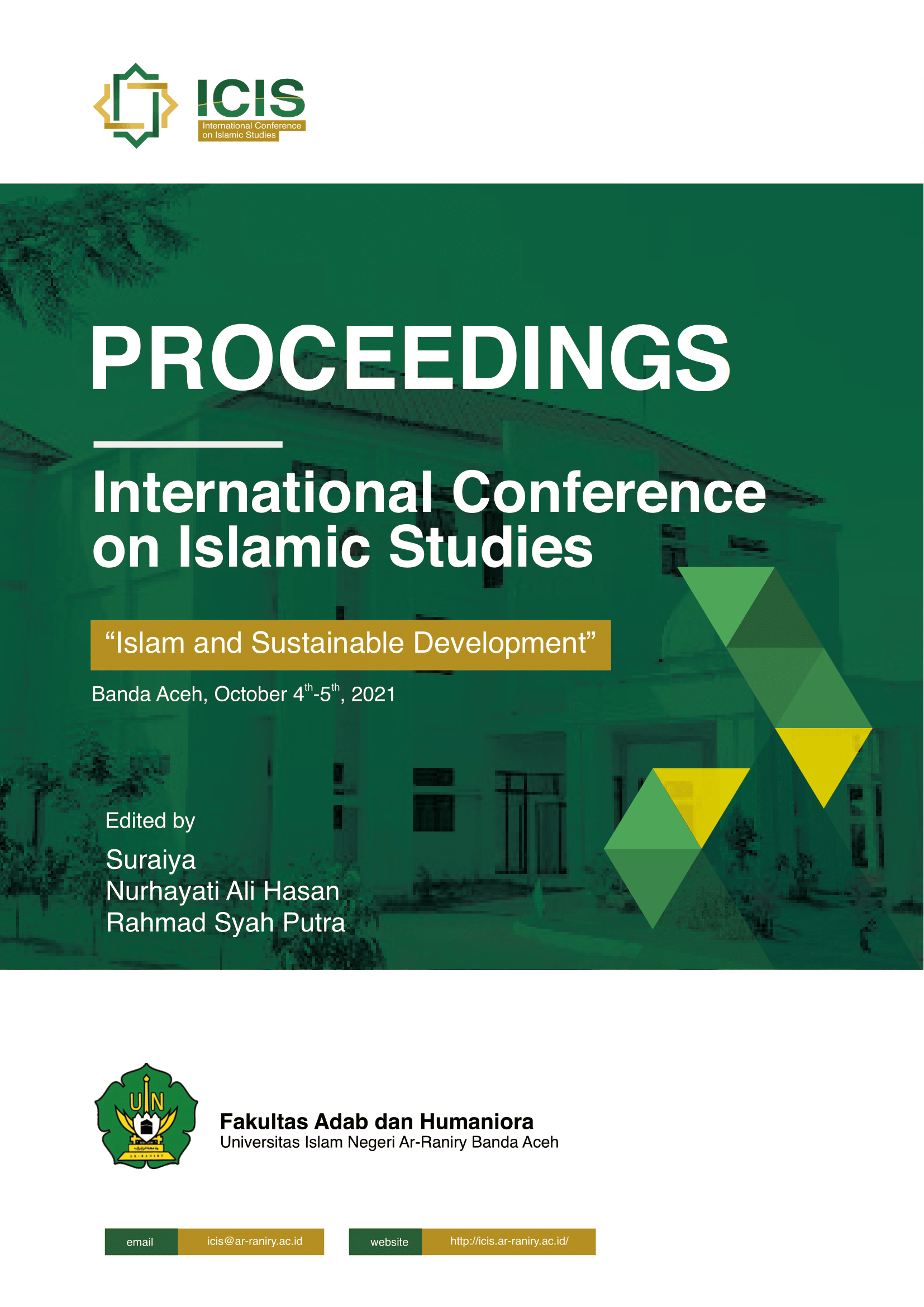BUILDING COMMUNITY COMMUNICATION AND WORSHIP IN INCREASING BODY IMMUNITY IN NEW NORMAL IN ACEH BARAT, ACEH AND LANGKAT NORTH SUMATRA, INDONESIA
Abstract
This study aims to identify the role of farmer communication and worship in increasing body immunity through qualitative methods. The sampling technique in this study was purposive random sampling using a questionnaire with open questions to 30 rice farmers in Langkat,
North Sumatra and Meulaboh, West Aceh. The results showed that there were 22 male and female farmers with 8 female androgynous farmers. As many as 73.33% of farmers prepare themselves and equipment (hoes and food supplies), then 20% of farmers clean the house and yard and 6.66% do bathing, dressing and masking. Then the data shows that 90% perform
special worship activities, such as ablution, Dhuha prayer and prayer before leaving for the land, only 10% perform worship when resting in the fields. Furthermore, farmer communication with extension workers during the New Normal period was carried out intensively and continuously (83.33%) and 16.66% stated that if there was free time and problems on the land, then met with agricultural extension workers. Farmers in general, 100% bring food from home that has been prepared such as rice, vegetables, side dishes and fruit, when buying and selling transactions in the fields / markets and communication is done by discussion, keep a distance of one meter and use masks among farmers and agricultural extension workers of 86.66%, only 13.33% did not use masks or talk very close
without distance. From interactions when collecting questionnaires, farmers stated adequate sleep-rest, communication according to health protocols, performing ablution and worshiping on time increases the immunity of the farmer's body so that optimal quality of life is achieved in the New Normal period. The role of farmers as the front guard, after the paramedics are providers of food needs to be supported and accompanied by academics,
agricultural extension workers, related agencies in maintaining food security in the North Sumatra and West Aceh Province of Aceh.
Kata Kunci: Communication, Farmers, Worship, Immunity, and New normal
References
Nugrayasa,O. 2013. “Tantangan dan Peluang Sektor Pertanian 2013”. Diakses dari http://setkab.go.id/en/artikel-6907-tantangan-dan-peluang-sektor-perta-nian2013.html
BPS Sumatera Utara. 2020. “Sumatera Utara dalam Angka 2020”. Diakses dari https://sumut.bps.go.id. Diakses pada tanggal 24 Juni 2020.
BPS West Aceh, 2020.
Hernandez peck, M. C. 2004. “Older Farmers: Factors Affecting Their Health and Safety” Diakses dari http://nasdonline.org/document/1825/d001760/older- farmers-factorsaffecting-their-health-and-safety.html
Soekartawi. 2005. “Prinsip Dasar Komunikasi Pertanian”. UI Press, Jakarta.
Waskita, I. 2012. “Laporan Kegiatan Analisa Usaha Tani”. Diakses dari http://teteto.wordpress.com/tag/sektor-pertanian/
Intani, A. C. 2013. “Hubungan Beban Kerja Dengan Stres Pada Petani Lansia Di Kelompok Tani Padi Kecamatan Sukowono Kabupaten Jember”. Skripsi Universitas Jember. Tidak dipublikasikan.
Oakley, K. 2008. “Occupational Health Nursing”. John Wiley and Sons, New York.
Huong et al. 2009. “Impact of tobacco growing on the livelihood and Health of tobacco farmers and the environment: a Preliminary study in vietnam”. Diakses darihttp://www.seatca.org/dmdocuments/29_impact_of_tobacco_growing_viet
nam.pdf
Siburian, P. 2007. “Empat Masalah Kesehatan Utama Pada Lansia”. Diakses dari http://www.waspada.co.id/, Diakses tanggal 29 Juni 2020.
Denura, F. 2013. “Tetap Sehat dan Aktif di Usia Lanjut”. Diakses dari
http://www.shnews.co/, tanggal 28 Juni 2020.
Effendi, F & Makhfudli. 2009. “Keperawatan Kesehatan Komunitas: Teori dan Praktik Dalam Keperawatan”. Slemba Medika, Jakarta.
Hariandja, M. T. E, Yovita, H. 2003. “Manajemen Sumber Daya Manusia: Pengadaan, Pengembangan, Pengkompensasian, dan Peningkatan Produktivitas Pegawai”. Grasindo, Jakarta.
Winarsunu, T. 2008. Psikologi Keselamatan Kerja. UMM Press, Malang.
Pyykkonen, P & Aherin, B. 2011. “Occupational Health and Safety in Agriculture”. Diakses dari http://www.balticuniv.uu.se/index.php/component/docman/doc_download/1293-chapter-53-occupational-health-and-safety-in-agriculture.
Chandra, B. 2006. “Ilmu Kedokteran Pencegahan dan Komunitas”. Jakarta: EGC.
Harrington,J.M. 2003. “Buku Saku Kesehatan Kerja”. EGC, Jakarta.
Moon, Y. S & Kim Do, H. 2013. “Association between religiosity/spirituality and quality of life or depression among living-alone elderly in a South Korean city”.
Udhayakumar, P dan Ilango, P. 2012. “Spirituality, Stress and Wellbeing among the Elderly practicing Spirituality”. Samaja Karyada Hejjegalu, 2 (10): 37-42. Diakses dari http://www.academia.edu/4284164/Spirituality_Stress_and_Wellbeing_among_the_Elderly_Prac tising_Spirituality.
Nilsson, J. 2005. “Understanding Health-Related Quality of Life in Old Age. A Crosssectional Study of Elderly People in Rural Bangladesh”. Abstrak. Diakses dari http://ki-su-arc.se/ understanding-health-related-quality-of-life-in-oldage-a-crosssectional-study-of-elderly-people-in-rural-bangladesh/.
Peres, K et al. 2012. “Health and Aging in Elderly Farmers: the AMI Cohor”t. BMC Public Health12:558. Diakses dari http://www.biomedcentral.com/1471-2458/12/558
WHO. 1996. “WHOQOL-BREF Introduction, Administration, Scoring and Generic Version of the Assessment”. Diakses dari http://www.who.int/mental_health/media/en/76.pdf.
WHO. 1997. “WHOQOL-Measuring Quality of Life”. http://www.who.int/mental_health media/68.pdf.
WHO. 1998. “Health Promotion Glossary”. [serial online]. http://www.who.int/ healthpromotion/about/HPR%20Glossary%201998.pdf?ua=1.[2 Juli 2020]

